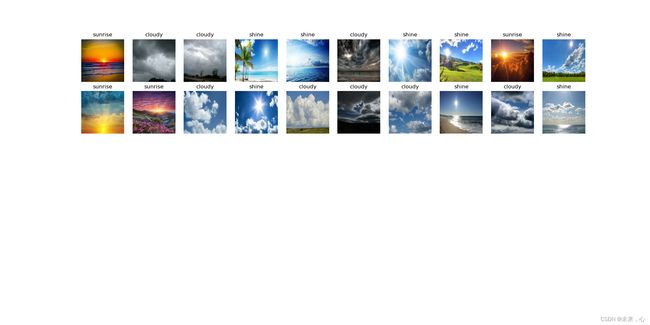CNN天气识别练习
活动地址:CSDN21天学习挑战赛
如运行中出现报错,类似以下报错,请更新tensorflow:
AttributeError: module ‘tensorflow.python.keras.api._v1.keras.preprocessing’ has no attribute ‘image_dataset_from_directory’
以下代码要求tensorflow版本大于2.5
pip install --upgrade tensorflow==2.5或pip install --upgrade tensorflow-gpu==2.5
数据集获取链接
链接:https://pan.baidu.com/s/1cE3GNeCY4bFaYCZpjM1-VA
提取码:orej
完整代码
# import tensorflow as tf
# gpus = tf.config.list_physical_devices("GPU")
#
# if gpus:
# gpu0 = gpus[0] #如果有多个GPU,仅使用第0个GPU
# tf.config.experimental.set_memory_growth(gpu0, True) #设置GPU显存用量按需使用
# tf.config.set_visible_devices([gpu0],"GPU")
# 导入数据
import matplotlib.pyplot as plt
import os,PIL
# 设置随机种子尽可能使结果可以重现
import numpy as np
np.random.seed(1)
# 设置随机种子尽可能使结果可以重现
import tensorflow as tf
# tf.random.set_seed(1)
from tensorflow import keras
from tensorflow.keras import layers,models
import pathlib
data_dir = "G:\BaiduNetdiskDownload\climate\weather_photos/"
data_dir = pathlib.Path(data_dir)
#查看数据
image_count = len(list(data_dir.glob('*/*.jpg')))
print("图片总数为:",image_count)
roses = list(data_dir.glob('sunrise/*.jpg'))
PIL.Image.open(str(roses[0]))
# 加载数据
batch_size = 32
img_height = 180
img_width = 180
"""
关于image_dataset_from_directory()的详细介绍可以参考文章:https://mtyjkh.blog.csdn.net/article/details/117018789
"""
train_ds = tf.keras.preprocessing.image_dataset_from_directory(
data_dir,
validation_split=0.2,
subset="training",
seed=123,
image_size=(img_height, img_width),
batch_size=batch_size)
"""
关于image_dataset_from_directory()的详细介绍可以参考文章:https://mtyjkh.blog.csdn.net/article/details/117018789
"""
val_ds = tf.keras.preprocessing.image_dataset_from_directory(
data_dir,
validation_split=0.2,
subset="validation",
seed=123,
image_size=(img_height, img_width),
batch_size=batch_size)
class_names = train_ds.class_names
print(class_names)
# 可视化数据集
plt.figure(figsize=(20, 10))
for images, labels in train_ds.take(1):
for i in range(20):
ax = plt.subplot(5, 10, i + 1)
plt.imshow(images[i].numpy().astype("uint8"))
plt.title(class_names[labels[i]])
plt.axis("off")
# 检验数据集
for image_batch, labels_batch in train_ds:
print(image_batch.shape)
print(labels_batch.shape)
break
# 配置数据集
AUTOTUNE = tf.data.AUTOTUNE
train_ds = train_ds.cache().shuffle(1000).prefetch(buffer_size=AUTOTUNE)
val_ds = val_ds.cache().prefetch(buffer_size=AUTOTUNE)
num_classes = 4
# 建立模型
"""
关于卷积核的计算不懂的可以参考文章:https://blog.csdn.net/qq_38251616/article/details/114278995
layers.Dropout(0.4) 作用是防止过拟合,提高模型的泛化能力。
在上一篇文章花朵识别中,训练准确率与验证准确率相差巨大就是由于模型过拟合导致的
关于Dropout层的更多介绍可以参考文章:https://mtyjkh.blog.csdn.net/article/details/115826689
"""
model = models.Sequential([
layers.experimental.preprocessing.Rescaling(1. / 255, input_shape=(img_height, img_width, 3)),
layers.Conv2D(16, (3, 3), activation='relu', input_shape=(img_height, img_width, 3)), # 卷积层1,卷积核3*3
layers.AveragePooling2D((2, 2)), # 池化层1,2*2采样
layers.Conv2D(32, (3, 3), activation='relu'), # 卷积层2,卷积核3*3
layers.AveragePooling2D((2, 2)), # 池化层2,2*2采样
layers.Conv2D(64, (3, 3), activation='relu'), # 卷积层3,卷积核3*3
layers.Dropout(0.3),
layers.Flatten(), # Flatten层,连接卷积层与全连接层
layers.Dense(128, activation='relu'), # 全连接层,特征进一步提取
layers.Dense(num_classes) # 输出层,输出预期结果
])
model.summary() # 打印网络结构
# 编译 设置优化器
opt = tf.keras.optimizers.Adam(learning_rate=0.001)
model.compile(optimizer=opt,
loss=tf.keras.losses.SparseCategoricalCrossentropy(from_logits=True),
metrics=['accuracy'])
# 训练
epochs = 10
history = model.fit(
train_ds,
validation_data=val_ds,
epochs=epochs
)
acc = history.history['accuracy']
val_acc = history.history['val_accuracy']
loss = history.history['loss']
val_loss = history.history['val_loss']
epochs_range = range(epochs)
plt.figure(figsize=(12, 4))
plt.subplot(1, 2, 1)
plt.plot(epochs_range, acc, label='Training Accuracy')
plt.plot(epochs_range, val_acc, label='Validation Accuracy')
plt.legend(loc='lower right')
plt.title('Training and Validation Accuracy')
plt.subplot(1, 2, 2)
plt.plot(epochs_range, loss, label='Training Loss')
plt.plot(epochs_range, val_loss, label='Validation Loss')
plt.legend(loc='upper right')
plt.title('Training and Validation Loss')
plt.show()
预测效果

精确度和损失值曲线过程曲线如下:

迭代10次效果不是很好,可以增加迭代次数,下面是迭代50次的精确度和损失值曲线:
 结论:从这个图可以看出,我们设计的网络着实不好,我这也是从别的地方当下来的,要想识别的更加准确,需要对网络模型进行调整,这里只是尝试这套代码的可行性进行了练习,并不涉及到深入调整,还真证实了不同的研究对象,需要有针对性的网络结构优化,有兴趣调整网络结构的小伙伴可以试一试。
结论:从这个图可以看出,我们设计的网络着实不好,我这也是从别的地方当下来的,要想识别的更加准确,需要对网络模型进行调整,这里只是尝试这套代码的可行性进行了练习,并不涉及到深入调整,还真证实了不同的研究对象,需要有针对性的网络结构优化,有兴趣调整网络结构的小伙伴可以试一试。
由于调制此代码,更新了tensorflow,导致我的GPU无法识别,缺少dll文件,这个我还没来及调试,具体方法我已百度到可以参考。不调用GPU着实慢。参考网站如下:https://blog.csdn.net/qq1198768105/article/details/124004146